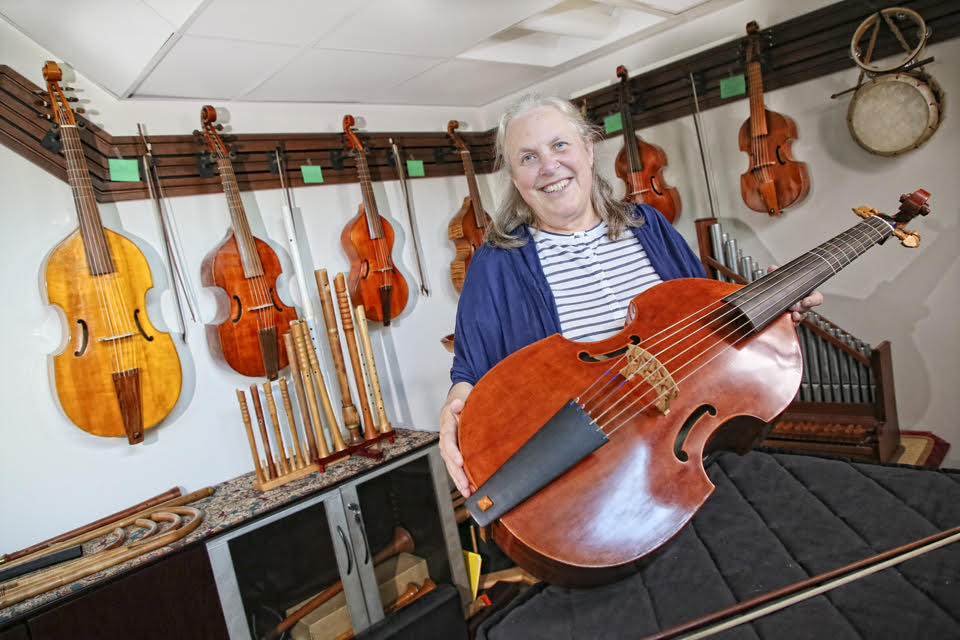Finding her sound through the viola da gamba
Sarah Mead discovered her sound at a young age through a unique instrument — the viola da gamba.
 Photo/Mike Lovett
Photo/Mike LovettSarah Mead posed among the department's many stringed instruments
Sarah Mead discovered her sound at a young age through a unique instrument — the viola da gamba. Familiarly known as the ‘viol’ with a similar appearance to a cello, this instrument has six strings, frets, and is primarily featured in European music from the 16th to the 18th centuries.
Mead, a professor of music, took the time to talk with BrandeisNow about her revelations in music, devotion to 16th-century music, and advice for young musicians.
What did you want to be when you grew up?
I was always drawn to music, but I had an image of what a musician was. I didn’t think that was me. I made music all the time throughout school, singing in the car with my family, playing instruments from a young age, and organizing my friends to make music with me. It didn’t occur to me that I could be a professional musician until college. Since I was so involved in choral singing, I eventually decided I would become a choral conductor.
Everything came together for me in college. My singing led me to an early music ensemble that also used instruments. When I heard the viola da gamba it was a revelation; that was the sound I had always been looking for! I played cello growing up, but this was different. It’s a melding of singing and the sound of low stringed instruments. I dropped everything and threw myself into that.
The viola da gamba isn’t a commonly known instrument. Why is that?
People have played the viola da gamba ever since it came onto the music scene in the late 15th century. However, it never became an orchestral instrument. The sound is suited for small, private intimate playing, rather than concert hall venues. When orchestras took over public concerts and became the norm, the viola da gamba became less visible.
I am most often requested to play the viola da gamba with my group, “Nota Bene”, made up of musicians from around the country that specialize in early music, but I also am hired to play in local ensembles. I’m most interested in performing works from the 16th and 17th century, so this works perfectly.
What draws you to 16th-century music?
I have a joke within my Facebook profile that my religion is “devoted polyphonist”. That’s what draws me to music. This style of music is like a conversation among friends at a dinner party where ideas get thrown back and forth between individuals. Fights or clashes are always resolved peacefully. There’s an equality among the artists, along with components of humor and inside references. It’s very much like a stimulating conversation.
I’ve found that while this style of music appeals to a niche part of the Brandeis community, students who discover it tend to stick with it, even years after they graduate. I continue to see former students who seek out early music as players, singers, and audience-members as I travel around the country. Even as far afield as Australia I’ve found a former member of the group making music with local players.
Are there any passion projects you’re currently working on outside of the classroom?
I was on sabbatical last semester and spent my time developing a program of 16th-century music that traveled large distances. I was able to identify pieces that showed up as far from their places of origin as Guatemala, Angola, and even Japan.
We know that Sir Francis Drake, an English explorer, always included a group of viola da gamba players in his travels. He would send them ashore in new lands before anyone else in the crew, to signal his peaceful intentions. It was thrilling to think of these sounds traveling so far, and being heard for the first time.
I have used this research to develop a professional program called “Continental Drifters” which my ensemble will be performing in various parts of the country this coming year. Music from this program will also form the basis of the December concert that my students in the Early Music Ensemble will be working on this semester.
I would also like to mention two collaborations with Brandeis faculty from other departments that are coming up: A collaborative course in music and humanities with Ramie Targoff of the english department, and a performance project based on an early 17th-century English masque with Ramie Targoff and Cameron Anderson of the theater arts department
What advice would you give to a student looking to pursue a career in music?I have served as an undergraduate advisor for 12 years, so I’ve shared this advice throughout the years. I always tell students to take as many different types of courses at Brandeis as you can. The courses I took as an undergraduate student outside of the music department still have a profound impact on me as a musician, from linguistics to color theory, to a hands-on course in book printing and binding. My music and my teaching would not be as broad or interesting if I hadn’t let those things into my life.
Categories: Arts, General, Humanities and Social Sciences, Research





